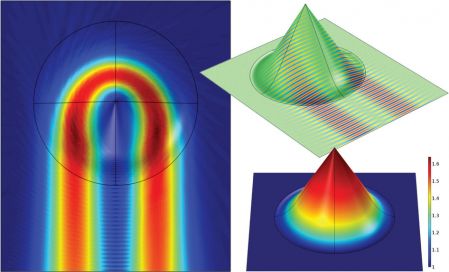 Menu
Menu
Sculpting surfaces to avoid impossible materials
Following on from work done by QUEST members Ian Hooper and Tom Philbin, a new elegant method of avoiding unrealistic or unrealisable material values when using spatial transformations has been described in "Removing singular refractive indices with sculpted surfaces", published in Scientific Reports. This method, valid for surface wave devices but not 3D wave devices, adds a simple deformation to the surface to allow a modified, simpler range of material properties to be used to create a device; without that deformation, the material properties remain challenging. This work builds on the work on perfect surface wave cloaks, but differs in some key areas, such as the size of the deformation in relation to the wavelength of the surface wave.
The paper includes three examples, but the technique can be used whenever a singular (infiinte) value of permittivity would otherwise be required for perfect operation.

A surface wave Eaton lens (retro-reflector). The device is excited using a planar narrow Gaussian beam with a wavelength of 1/10th of the radius of the deformed region offset to one side of the device. The left panel shows a top–down view of the time averaged field within the device, clearly showing the desired function of retro–reflection. The top right panel shows the instantaneous z–component (normal to the average plane of the device) of the electric field on an isometric projection of the device, where we can see the role of the tip in redirecting the incoming waves. The bottom right panel shows the required index, N(R) that must be present in the deformed region of the waveguide.
Image and caption from the paper.
